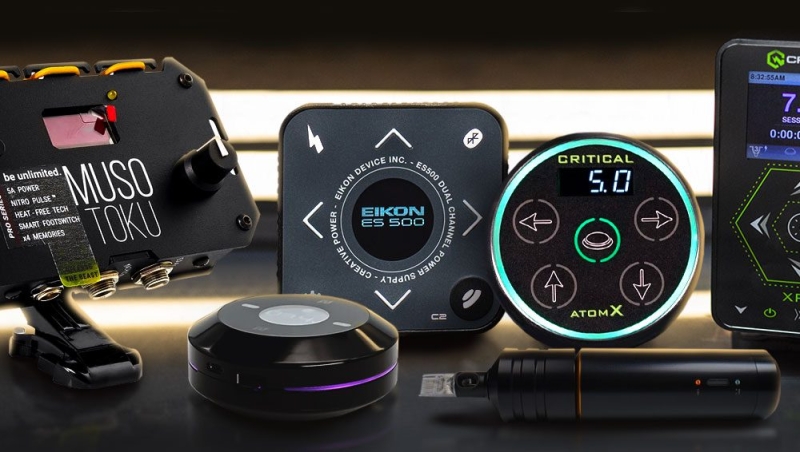Contents
- 1 Considerations for Choosing a Tattoo Power Supply
- 2 Exploring Types of Tattoo Power Supplies
- 3 Key Electrical Terms to Know When Selecting a Tattoo Power Supply
- 4 Connection Types: RCA vs. Clip Cord
- 5 Navigating the Features of a Tattoo Power Supply
- 6 Optimizing Voltage for Tattooing
- 7 Understanding the Role of the Foot Pedal
- 8 Our Top Power Supply Picks
GuideReviewsUncategorized The Complete Guide to Power Supplies

Julian Brzozowski June 8, 2024 8 Mins Read
Tattoo machines require a reliable power source to operate effectively, with the power supply being a critical component. It not only energizes the tattoo machine but also enables artists to manage the voltage, influencing the machine’s speed and intensity. For any tattoo artist, understanding how to adjust the power supply for various tattooing tasks, such as lining or shading, is fundamental. This article will delve into the intricacies of tattoo power supplies and provide practical advice to help you select the best option for your needs.
Considerations for Choosing a Tattoo Power Supply
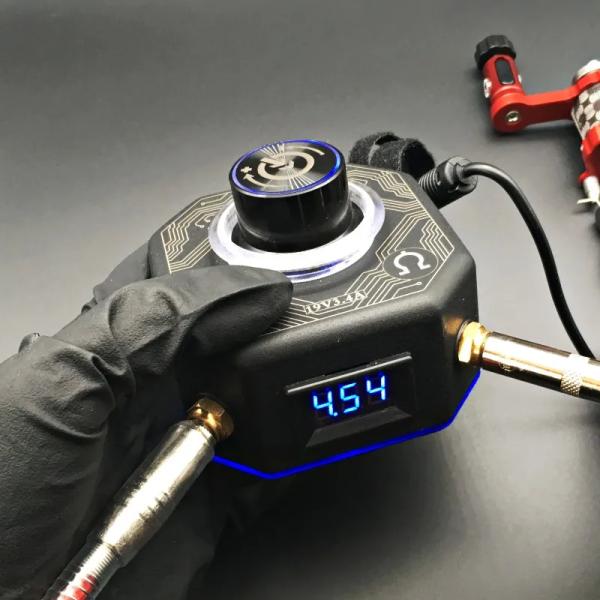
Selecting the right power supply involves evaluating several key factors:
- Consistent Performance and Reliability: Ensuring the power supply delivers stable and reliable output.
- Compatibility: Identifying the correct type of connection for your tattoo machine, whether it’s RCA, clip cord, or wireless.
- User-Friendliness: Opting for a power supply that is easy to operate.
Our evaluations are conducted by seasoned tattoo artists who test these power supplies in real-world tattooing settings, ensuring our reviews are based on genuine, practical experience. Our goal is to equip you with detailed and actionable information to make an informed decision.
Exploring Types of Tattoo Power Supplies
Understanding the various types of tattoo power supplies available is crucial for making an informed choice:
Digital Power Supplies
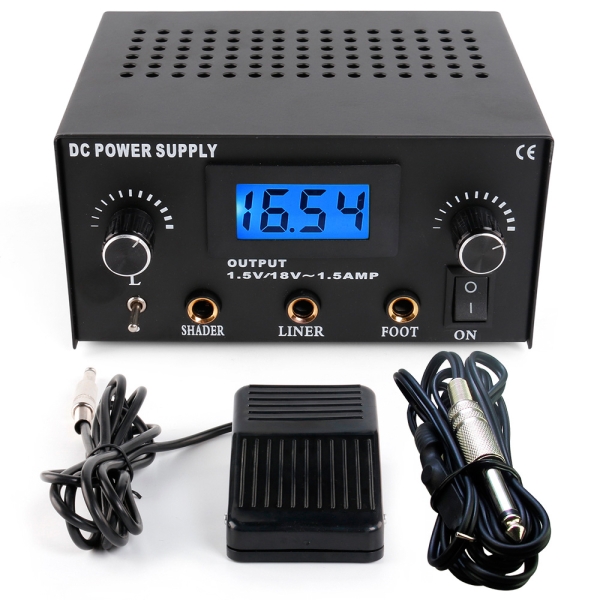
Digital power supplies are prevalent in today’s market, featuring a digital display for easy monitoring of settings, even from a distance. These devices are versatile in design and size, facilitating straightforward voltage adjustments and troubleshooting.
Analog Power Supplies
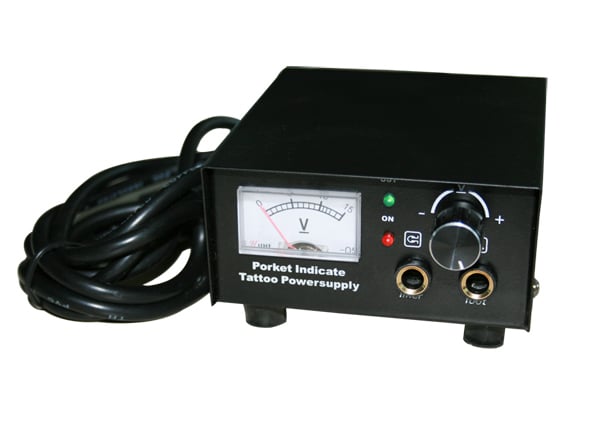
Analog power supplies display their settings on a dial that may resemble a compass. They require close observation to monitor ongoing power levels. Historically, analog units were considered more durable than digital ones, though recent technological advances have significantly closed this performance gap.
Wired and Wireless Power Supplies
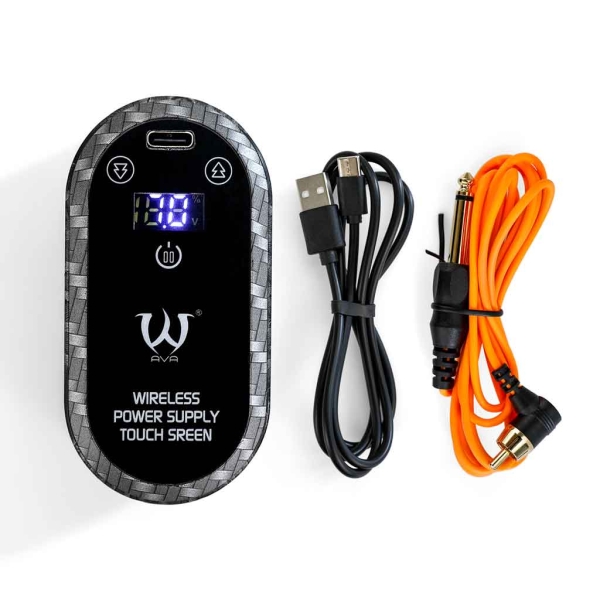
The traditional setup involves wired power supplies, where a cable connects the power supply to the tattoo machine. In contrast, wireless power supplies use an RCA connection, offering compatibility with most modern rotary tattoo machines without the need for cables.
Key Electrical Terms to Know When Selecting a Tattoo Power Supply
- DC (Direct Current): DC is used by all tattoo power supplies to ensure the machine operates smoothly. It flows in a single direction, converting AC from your power outlet into usable DC.
- Volts and Amps: Voltage measures the pressure of the electrical current, akin to water flowing through a hose, while amperes (amps) measure the current’s rate, similar to the water’s flow rate through that hose.
- Jump/Kick Start Feature: This is essential for certain rotary machines that require a higher initial power output to start operating. Knowing whether your machine needs this feature can save time and reduce frustration.
Connection Types: RCA vs. Clip Cord
The type of connection you choose depends largely on the kind of tattoo machine you use:
- Coil Machines: These typically use clip cords. The cords’ prongs insert into the machine, facilitating the electrical current necessary for operation.
- Rotary and Pen Tattoo Machines: These often use an RCA connection. Many pen machines also feature integrated batteries that can be recharged directly, simplifying the setup.
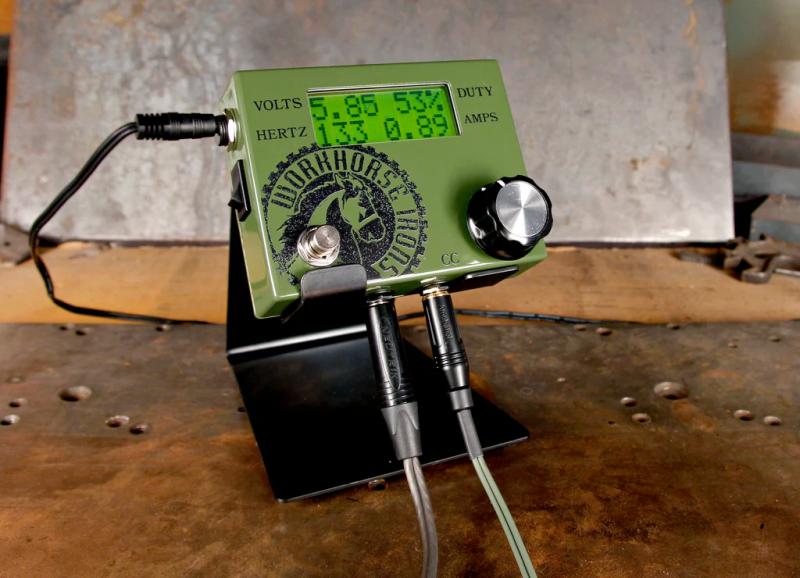
For those new to tattooing, understanding the settings on your power supply is vital:
- Power Switch: Simply turns the power supply on and off.
- Voltage Dial: Allows you to adjust the voltage output. Digital controls are preferred for their ease of use and hygiene, as they can be covered more effectively during sessions.
- Voltage Display: Keeps track of the voltage being used, critical for consistent tattooing results.
- Dual Switch: Enables connection and switching between multiple machines if needed.
- Duty Cycle (For Coil Machines): Indicates how long the needle is in contact with the skin during operation, typically aiming for a 50% duty cycle for balanced performance.
Optimizing Voltage for Tattooing
Tattoo power supplies generally offer a voltage range from 4 to 12 volts. The optimal voltage setting depends on the tattooing style and the machine’s mechanical design. Starting with a lower voltage is advisable, gradually increasing to find the ideal setting that complements your hand speed and technique.
Understanding the Role of the Foot Pedal
The foot pedal acts as a switch, controlling the power supply’s current to the tattoo machine. While essential in traditional setups, it becomes optional with wireless systems. Some artists prefer to operate without a foot pedal, keeping the machine running continuously, although this may not always be convenient.
Our Top Power Supply Picks
Kiprim Programmable DC
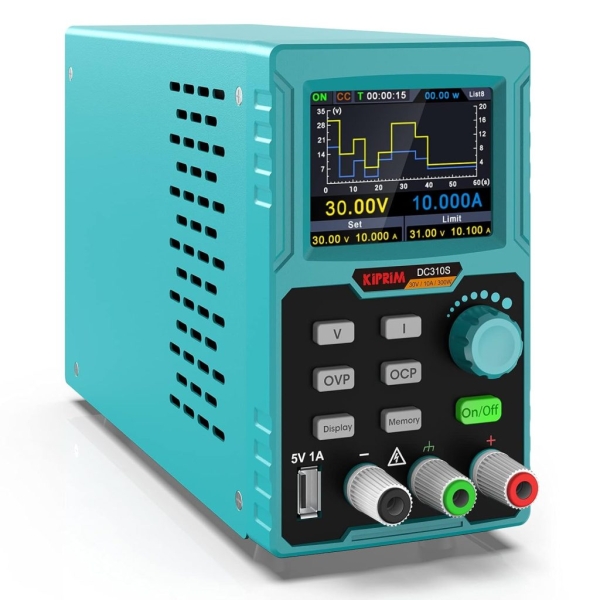
The Kiprim Programmable DC Power Supply is an impressively compact and multifunctional unit, ideal for those who need precise control over their projects. This power supply boasts a variety of protections like overvoltage and overcurrent, coupled with a smart cooling fan that adjusts its speed based on the load, reducing operational noise effectively.
Pros:
- Versatile Display Options: Offers both numerical and graphical displays, allowing for easy monitoring and adjustments of voltage and current.
- Memory Function: Features four memory slots for quick setup and repeatability, enhancing user convenience significantly.
Con:
- Button Sensitivity: Some users reported issues with the power button’s responsiveness and the absence of adjustment keys, making parameter changes more cumbersome than expected.
Overall, this power supply shines with its clear and informative 2.8-inch color LCD display, showing all necessary output details. It’s particularly suited for users who appreciate the ability to track their settings visually through a history graph. However, some might find the button interface and fan noise a bit challenging, especially in quiet environments. Despite these minor setbacks, its compact size and robust functionality make it a worthy consideration for both professional and hobbyist use.
Mast Tattoo
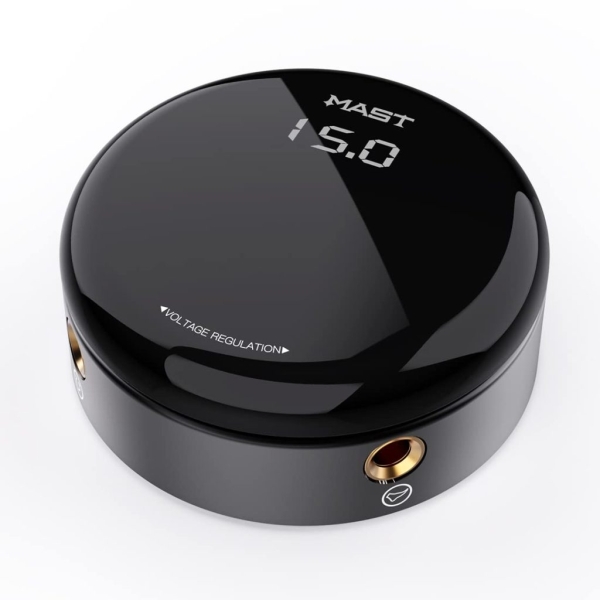
The Mast Halo2 Tattoo Power Supply is a game-changer in the world of tattoo artistry, combining cutting-edge technology with user-friendly features. This power supply ensures consistent performance with its precise voltage adjustments and the innovative 360-degree rotational OLED display, which enhances visibility and flexibility in any tattooing setup.
Pros:
- Intuitive One-Touch Controls: The touch control interface is straightforward, making it easy for artists to adjust settings quickly.
- Rotatable OLED Display: Provides clear visibility from any angle with its 360-degree rotational capabilities, enhancing ease of cable management and machine control.
Con:
- USB-C Only: Limited to a USB-C connection, which may require adapters for compatibility with other devices or older equipment.
This power supply excels in providing stable and adjustable power, critical for detailed tattoo work. Its sleek design not only adds a modern touch to the workspace but also offers practicality with its compact size and USB-C connectivity, ensuring it fits seamlessly into professional environments. While overwhelmingly positive reviews are a strong endorsement, the lack of negative feedback could leave some users wondering about its untested aspects. Nevertheless, the Mast Halo2 is evidently a top-tier choice for those seeking reliability and precision in their tattooing equipment.
Pirate Face Tattoo Duo
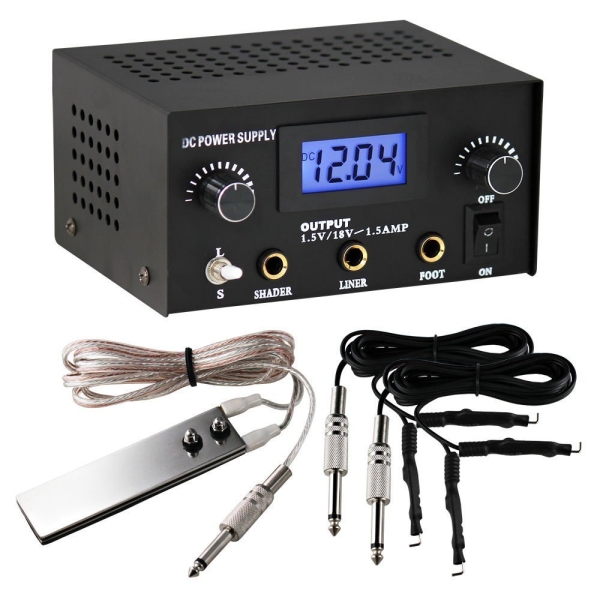
The Pirate Face Tattoo Dual Digital Tattoo Power Supply is a versatile unit designed to cater to both beginners and experienced tattoo artists. It features dual machine hook-ups that allow seamless switching between liner and shader machines, enhancing workflow efficiency. The power supply is equipped with an ultra-bright LCD display that provides clear readings of voltage, amps, speed, duty cycle, and follow-through, offering superior control over the tattooing process.
Pros:
- Dual Machine Capability: Allows easy switching between two machines with dedicated knobs for each, reducing setup time.
- Comprehensive LCD Display: Offers detailed real-time monitoring of machine settings for precise adjustments.
Con:
- Clip Cord Quality: Some users have reported issues with the durability and reliability of the included clip cords.
The Pirate Face Tattoo Dual Digital Power Supply stands out for its professional-grade quality and affordability. Its preset functions for liner and shader machines streamline the tattooing process, making it easier to focus on artistry. However, despite its many advantages, some users have noted that the clip cords that come with the unit could be of better quality. This minor drawback aside, the power supply is highly valued for its functionality and ease of use, making it a worthy investment for any tattoo artist looking for reliability and versatility in their equipment setup.
BRONC
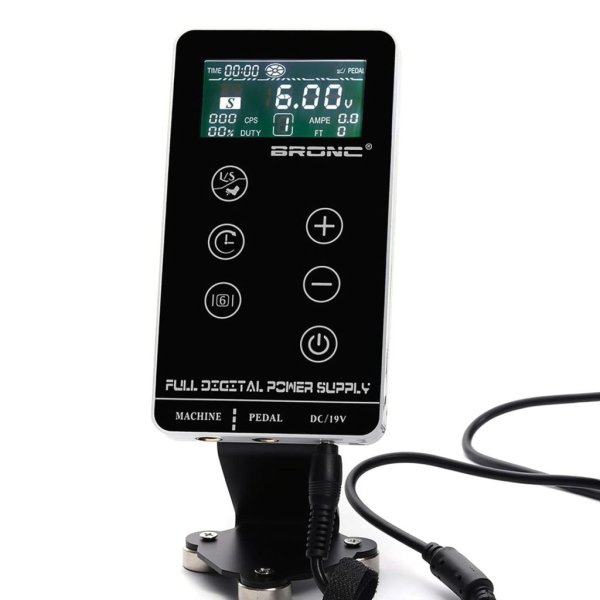
The BRONC Professional Tattoo Power Supply features a touch screen digital LCD that enhances the precision and ease of control for tattoo artists. This advanced unit is designed to cater to the demands of professional environments, offering consistent and clean power across a wide range of settings.
Pros:
- Responsive Touch Screen: Provides an intuitive interface for quick adjustments and monitoring, making operations smooth and efficient.
- Versatile Settings: Includes liner/shader presets with memory modes and foot switch options, catering to diverse tattooing styles and preferences.
Con:
- Reliability Issues: Some users have reported unexpected power cuts and settings resetting to default, which could disrupt a professional tattoo session.
This power supply stands out for its modern touch screen feature and robust output capabilities, ensuring that artists can work with precision. The inclusion of customizable presets and adjustable modes adds to its professional appeal, making it a popular choice among those who value efficiency and flexibility in their tools. However, concerns about its reliability, particularly in terms of maintaining power stability, suggest that it may be better suited for practice rather than critical, high-stakes tattooing sessions. Despite these issues, the BRONC power supply offers significant value and could be a viable option for artists looking for advanced features at a reasonable price.
As you delve into the world of tattooing, selecting the right power supply is just as crucial as choosing the correct needle or ink. By understanding the types, features, and settings of various power supplies, you can enhance your tattooing efficiency and safety, ensuring both you and your clients are satisfied with the results.
Tags:
electricequipmentmachinepowerpower supplyrotary machinesafetytattoo machinetechnique
